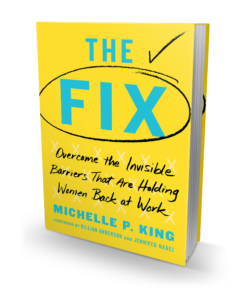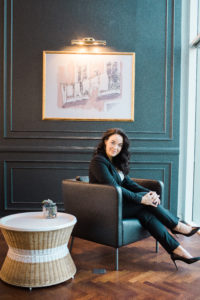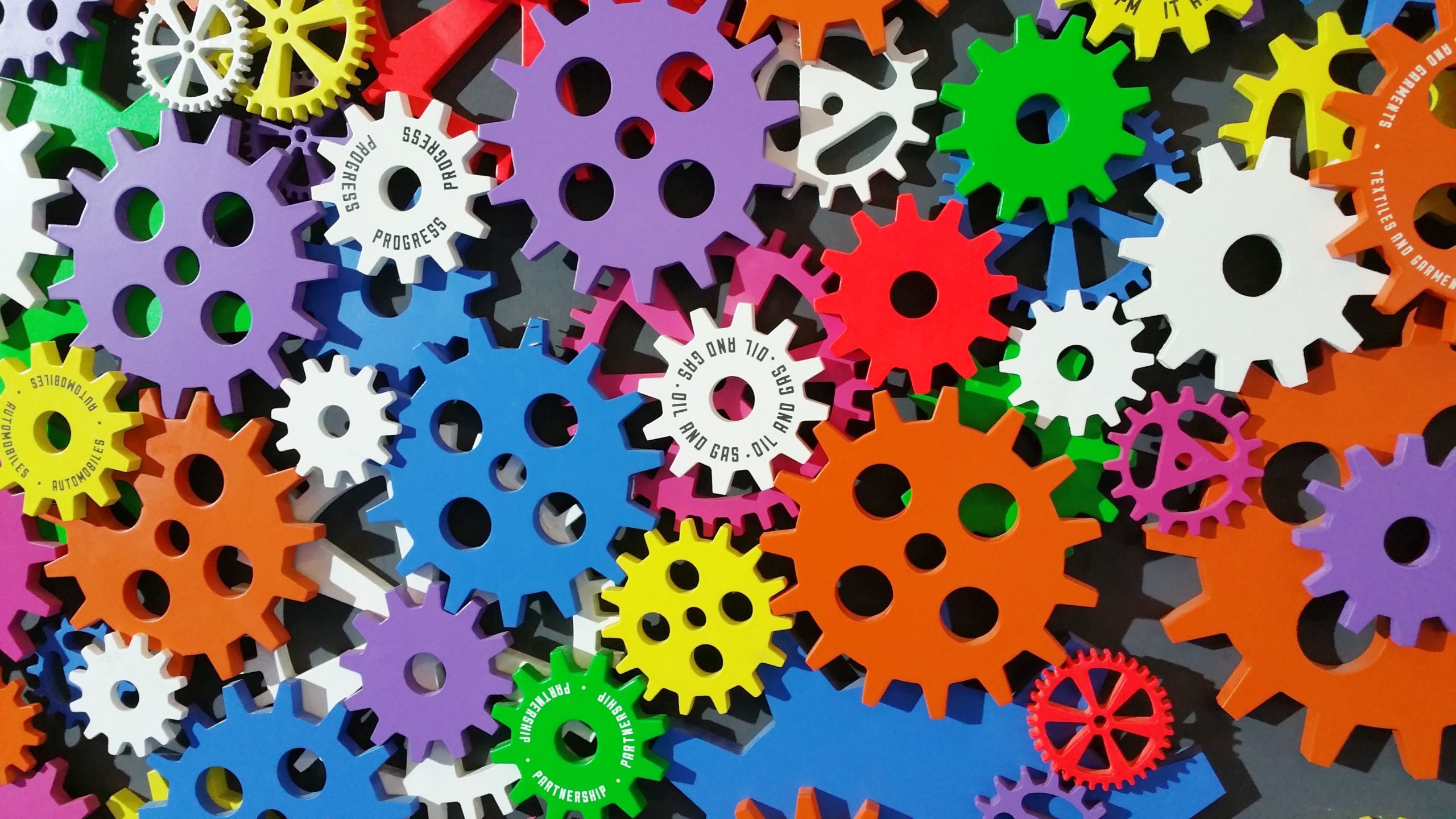Fixing the Workplace in This Emergent, MeToo Era
As the Covid-19 pandemic rages on worldwide, New Zealand’s Prime Minister Jacinda Ardern, 39, is earning praise for her government’s swift and compassionate response to the virus — now practically eradicated from the country. Well before the global crisis hit, Ardern was interviewed by Michelle King and appears in King’s new book The Fix: Overcome the Invisible Barriers That Are Holding Women Back at Work. King asked: “What do you want your government to be known for?” Ardern replied: “I want our government to be known to have been kind.”
What can leaders and workplaces take from Ardern’s example? As King sees it, Ardern speaks to a different leadership model based on values, one that’s vital for current and future workplaces to be successful. I spoke to King recently about cutting through the denial of workplace inequality, considering the MeToo movement’s impact, and closing inequities. What’s crucial is to listen to the diversity of lived experiences, throw off old notions of the ideal leader and worker, and create cultures of equality that harness employees’ differences for our emergent era. Excerpts of our interview are below.
 Americans’ views of the MeToo movement
Americans’ views of the MeToo movement
Impact of the MeToo movement on workplaces
How denial of inequality manifests in the workplace
Why storytelling breaks through denial
How King employed storytelling to show inequality
Why Don Draper from Mad Men matters
Social capital’s significance in the workplace
How to value mothers
Navigating workplaces today
Why companies with cultures of equality will outcompete their peers
Americans’ views of the MeToo movement
As background, the American Communities Project recently analyzed December 2019 survey results from Dynata about the state of the MeToo movement across the country and within community types. On average, 42% of Americans say MeToo has done its job; 36% say it’s gone too far; 22% say it hasn’t gone far enough. However, opinions look different at the community type level. More than a quarter of people in Hispanic Centers and the African American South say the movement needs to go further. In two small rural communities, Aging Farmlands and LDS Enclaves, a clear majority of people believe MeToo has gone too far.
Which of the following best represents your feelings about the MeToo movement?
As the table above shows, people’s feelings markedly differ by community type.
Below King shares how she sees the MeToo movement as well as how organizations deny gender biases, how they can improve their cultures, and why it’s necessary.
Impact of the MeToo movement on workplaces
I’m not a spokesperson for MeToo, but I would just say it’s raised awareness and disrupted people’s denial around how we still have a really long way to go. The MeToo movement is advocating for what I see as the fundamental human right, which is to feel safe at work. That’s the bare minimum. I think a lot of women and men were kind of shocked to realize that we’ve got a long way to go. I think by the time people are raising sexual harassment and assault issues in your workplace, you have lost; your culture is broken, and it needs to be fundamentally fixed.
This is a cultural issue because in every one of those instances somebody could have spoken up, somebody could have said something, somebody could have been an ally, but they didn’t have the right environment that enabled that.
How denial of inequality manifests in the workplace
I’ve been doing a lot of work on this recently for my PhD paper. I think it starts with the general lack of awareness about how inequality works. Normally you’ll see that with the belief that it’s a workplace with a meritocracy. An example of how that plays out now is the willful blindness we see in workplaces when it comes to the challenges of how Covid-19 is detrimentally impacting the productivity of mothers. It’s detrimentally impacting black colleagues because of systemic racism and issues related to health around that.
There’s this willful blindness around how not all experiences of the pandemic are the same. And even though companies may acknowledge it, or occasionally pay lip service to it, there’s this tendency to be like OK, business as usual. And let’s just have the meetings; let’s just require everybody to be at the same standard while ignoring that the playing field is not level. A lot of mothers are the primary dependent caregivers. That creates tremendous challenges for working mothers.
But what we also see just more generally in relation to gender denial is the denial of difference or different experiences of work. So you’ll be hearing managers say things like the workplace is a meritocracy. You’ll hear them say women don’t experience any barriers. I mean I’ve got loads of men writing to me as my book’s come out, making all sorts of comments around the invisible barriers because there’s just this belief that if you work hard you’ll succeed, right, that all the biases and prejudices that we had before we stepped into workplaces somehow disappear. And it’s simply nonsense.
Why storytelling breaks through denial
Storytelling is a key. We’ve had these really annoying business cases around diversity and inclusion for years. The reality is that does nothing; it just leads to token efforts, around quotas, or what I call women-fixing, women leadership development programs, mentoring, anything that helps women fit into workplaces that don’t really value them in the first place.
Storytelling is actually one of the tools you have for disrupting all of that because it shows you the lived experience of workplaces. In my book, I share many, like the time my boss just threw a dish towel at me and told me to wash the dishes in the sink because I was the only woman on the team. And nobody said anything. Everyone had this muffled laugh.
Or the time that I was working, and this isn’t in my book, but I was working for very large organization and I was pregnant with my second child, and the CFO I was working for said to me, this is why I don’t like hiring women because they go off and have babies.
You have those moments, where you’re kind of slapped with prejudice and discrimination. It’s in those moments that you realize, oh, this workplace doesn’t work for me in the same way that it does you because you don’t value me. It all comes down to value and the way in which we value each other. I think storytelling compels us to want to fix inequality that we know our colleagues are experiencing.
How King employed storytelling to show inequality

I used the power of storytelling when I was doing my PhD and working with the senior male partner in this professional services firm who denied my research. I had surveyed over 1,000 men and women in this organization. I had countless hours of interviews. I had so many data points, and I could point to all of them and say look, overwhelmingly 87% of women and men are saying the organization is gendered and that creates challenges for them. And he just ignored it. He was like, I don’t believe your data points; you have biases. These data points aren’t great; he just came up with every excuse to not look at it.
I said I’ll tell you what, maybe all of what you’re saying is true. So why don’t we just step back from this and to test what I’m saying is actually correct and my research is correct? Why don’t you go out and speak to two or three women that you trust in your workplace, and ask them about their lived experience, and ask them whether they’ve witnessed or experienced inequality moments throughout their careers? Ask them if this data resonates. And he did, and he was blown away. I mean these were women he worked with every day, who he trusted, who had never once spoken up and told him just how different their experience in the work environment was.
And that was the catalyst to shift his denial and get him to a place where he was like wow; actually I’m a leader and I’m responsible for this experience of the people who work for me, and they’re not enjoying this experience, so I’ve got to do something. That’s where I met him on his journey to wanting to create a culture of equality.
Why Don Draper from Mad Men matters
I love Don, because I think Don in my book is such a good example of how prototypes work. Most organizations are hardwired for an ideal type of leader. When you think of what good looks like, pretty much in any organization, research over 30 years in any geographical context has shown that you’re going to think of a white, middle-class, heterosexual, able-bodied male.
But importantly, you’re also going to think of somebody who is willing to engage in dominant, assertive, aggressive, competitive, and even exclusionary behaviors to get ahead. The problem in organizations when that’s the ideal — and it’s been ideal standard since the 1950s — is leaders lead in that way. They encourage employees to behave in that way, and then that creates entire cultures that reflect those behaviors as values. That’s really what creates inequality because the more ways that you differ from this Don Draper-ideal, the more barriers you’re going to face trying to advance at work. And the more ways you’re similar, the more privilege you have because it’s easier. It’s an unearned benefit you get from naturally fitting the ideal standard.
The Don Draper-ideal standard came about in the 1950s with Ford Motor Company, and it might have served us when workplaces were pretty much all men — it doesn’t serve us today. When I think of COVID-19 and the types of leadership behaviors we need to manage remote workforces, the old-school, command and control, transactional style of leadership just doesn’t work. We need leaders who can be transformational, leaders who can be empathetic, who can be democratic, who can be caring, and those are behaviors typically associated with women leaders.
Social capital’s significance in the workplace
My PhD is actually on organizational politics, which is when you engage in the political aspects of work that are inevitable for how organizations function. You do that to gain social capital. Think of it like a bank, and you build up enough credit with your colleagues at work so that when you need something or you want something, you can go and cash it in, right. You build up that goodwill through developing relationships, forming coalitions, supporting your colleagues when they need it.
It’s a lot easier to build those relationships if you are similar to individuals in terms of values, but also in terms of backgrounds. So if you look the same, think the same, act the same, went to the same school, it’s easier to develop that relationship. It’s easier to cultivate social capital. That’s why the political aspects of work are incredibly unfair because they enable individuals to develop with access to networks like the boys’ club or form relationships with powerful people, and it’s often to the detriment of underrepresented groups in organizations who don’t have their race or gender or ethnicity or economic background in common with people who are in positions of power.
It’s such a great example of how workplaces are not equal and why hard work doesn’t necessarily guarantee success because you can do everything right, but still not advance because you don’t have the needed social capital to get that promotion or to get access to the high-profile development opportunity.
So social capital in organizations is everything, far more important than IQ or EQ, but getting it is what can be incredibly challenging for individuals who come from underrepresented groups.
How to value mothers
As The Fix states: “Mothers suffer a per-child wage penalty of approximately 5 percent per child on average after controlling for the usual factors that affect wages.”
The one thing that works with the motherhood penalty, and it’s so frustrating because we don’t talk about it enough, is publishing salary data. When you publish your salary data, you’re accountable for closing the gap. In my book I’ve got some case studies that have done this. Making that public commitment to opening up the books and showing people where the gaps are and how they’re going to close them, that’s how you do it. We shouldn’t have these pay gaps. We shouldn’t be devaluing mothers because they most strongly are the antithesis of Don Draper.
It’s just frustrating that organizations devalue women, particularly when a study by the same Federal Reserve Bank of St. Louis came out showing that over a 30-year period, mothers are the most productive workers, and particularly mothers of two children. Now any mom reading this article is going to be like, well, of course, it makes complete sense because we know how hard we have to work and how efficient we have to become, right; these are life skills.
It starts with creating cultures that value mothers. It’s not enough to have a flexible workplace policy in place, or maternity leave; you have to create a working environment that fundamentally values the contributions that mothers bring.
Navigating workplaces today
I think you’ve got to choose your company wisely. I make it a practice now when I’m interviewing for a job to really ask the leaders in organizations how they practice equality, what inclusion means to them, where or how they’re personally committed to it, what do they do day-to-day to create cultures of inclusion.
For people who are being passed over if you’re already in an organization, it’s very hard to advocate for yourself, as I share in the book with Sarah. I actually advocated for her. That’s why we need to develop cultures of allies, where we can be allies to one another. It’s much easier for women to advocate for one another.
I also don’t like asking underrepresented groups to advocate or solve inequality they had no part in creating, so this is more about those in positions of power and privilege, particularly white males. They can spend that privilege by really speaking out and advocating for women, asking why, when they’re confronted with decisions that seem to be biased, and pushing organizations to think differently.
Why companies with cultures of equality will outcompete their peers
It’s really basic; companies that have cultural equality will outcompete their peers because they will be more innovative. They’ll have different perspectives around the table that they value and so they’ll be able to utilize those different perspectives to achieve better outcomes. We see this play out in that Accenture study that showed in cultures of equality, companies are six times more likely to have employees that have an innovation mindset.
You’re just more likely to create the right environment for innovation, which is needed in the future world of work because we’ve got changes coming, disruptive changes. It’s not just Covid-19, but AI, robotics, nanotechnology. That’s going to happen in the next three to five years. The companies really have to get with it.
Don Draper is not going to serve us in the organization of the future. We need transformational leaders. We need empathetic leaders, leaders that have the cognitive, behavioral, and emotional flexibility to lead in different ways and adapt to change and be responsive.
